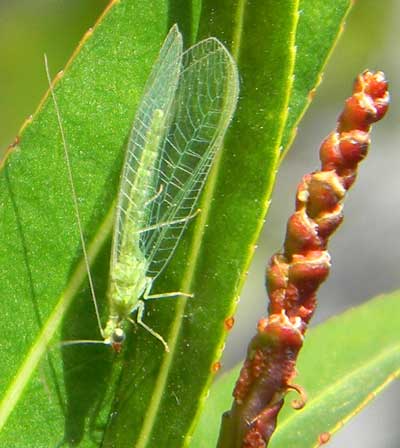
Other Urban Habitats
Grenada Park Scottsdale Ponds Desert Botanical Garden
Arizonensis --> Sonoran Desert Naturalist --> Urban Habitats --> Backyard Naturalist --> Garden Pests?
Your Garden Insect Guests
You protest! "These bugs eating my plants are not my guests. They are uninvited!!" But, please step back and try to look at the World through the compound eyes of an insect: Here's a patch of healthy green plants in an otherwise barren and asphalted cityscape. There's water and shade beneath a canopy of leaves. Flowers and fruit in bounty. Room and board for sure. Don't see the 'no vacancy' sign. Time to settle down and start a family!
Once you've lured these hungry, winged, six legged wildlife you have several choices on how to deal with them. Remember, no matter what you do, they will keep coming so long as your invitation flies. A garden naturalist will fully accept that insects are a fitting part of gardens and let them be. If you're like Faber (best known 19th Century French gardener and bug watcher) you'll soon learn that with a good hand lens and a bit of spare time the insects in your garden offer adventure and drama right at your door stoop.
A garden with plenty of insect life is friendly to birds and lizards and toads. The vast majority of garden wildlife depends upon insects as food. Verdins, hummingbirds, and flycatchers follow the bugs into your garden. Certainly you can appreciate colorful feathers and glorious song. And like the canary in the coal mine, the presence of all these delicate creatures, full of vibrant life says your garden is a healthy place to be.
But you protest again! There's aphids drawing sap from the roses, chunks of leaf eaten from the turnips, and the hibiscus is coated with white flies and sooty mold. Plants have been surviving the insects for eons and have long since developed the ability to tolerate quite large numbers of plant feeders. Plants grow back. They also deposit phytochemicals in their leaves to reduce attack.
Besides the hordes of plant feeding bugs that come looking for a bite, there are also as many 'beneficial' insects and spiders that are looking for places to hunt for their prey. By the time you notice the aphids, chances are the predators have as well. Plants that are under attack by aphids or caterpillars often send out minute quantities of aromatic chemicals called keromones that are calling signals to the predaceous beneficials.
No doubt you are familiar with some of the more conspicuous beneficial insects. And sometimes you may be encouraged to purchase them for release in your garden. Green lacewings are delicate looking as adults, but the larval form which is about 5 mm long is a ravenous predator of aphids, whiteflies and caterpillar eggs. Colorful Lady Bird Beetles are another well known beneficial. Typically orange or red with spots, both adults and larvae feed on aphids and other sucking bugs. Assassin Bugs of several kinds ranging up to 10 or 15 mm can also be found lending a hand at keeping caterpillars and such in check. An inspection of your garden might prompt you to want to get more of these good bugs and release them in your garden. Unfortunately, this will not help. Lacewings when set to artificially high numbers resort to cannibalism … there's an upper limit to how many can live on your plants. Lady Birds (aka ladybugs) are sometimes offered for sale, but they are highly migratory and will likely fly off within days of their release. Assassin Bugs and Preying Mantis eat plenty of bugs but have little impact on the ones that are causing your concern.

Aptly named Green Lacewing.
So, is there no way to rely on the beneficial insects to combat the plant feeders? Answer is the beneficials are already there in your garden - if you're pesticide free. It's just that the vast majority of the ones that really count and do the most to keep the plant feeders in check are so small that a powerful magnifying glass or microscope is needed to even see them!! Encarsia, the number one beneficial against whiteflies is smaller than a period on this printed page. Syrphid larvae, which eat prodigious numbers of aphids look like nondescript miniature slugs. And microscopic Trichogramma get many caterpillar eggs before they ever hatch.
Many of these microscopic helpers are highly susceptible to pesticides. Once they are wiped out the plant feeders will come back with a vengeance, often within days of the chemical treatment. This is called the 'pesticide treadmill'.
Outbreaks of plant feeders will sometimes occur in pesticide-free gardens. This can have varied causes. Vast numbers of plant feeders sometimes migrate from agricultural fields, native vegetation or even nearby regions. Moths, grasshoppers, seed bugs and whiteflies are usual culprits. In this case there really are no effective means for the gardener other than to wait out the 'plague'. Highly toxic pesticides would be ineffective unless applied every few days. Best advice is to ride out the storm and replant later as necessary.
Outbreaks of specific pest species within a garden can sometimes be lessened by helping the predators.
OK, OK! If there are limits to your tolerance of large numbers of insects munching and sucking your prize plants here are some suggestions:



Copyright Michael J. Plagens, 1999-2009